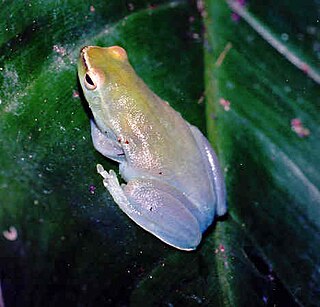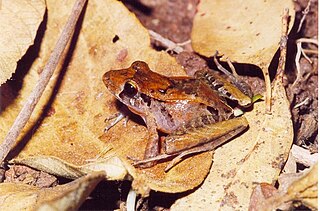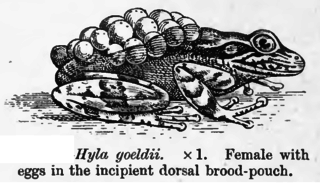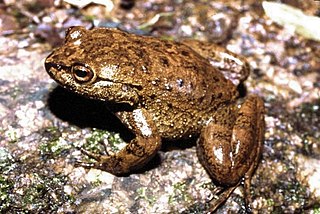
The southern frogs form the Leptodactylidae, a name that comes from Greek meaning a bird or other animal having slender toes. They are a diverse family of frogs that most likely diverged from other hyloids during the Cretaceous. The family has undergone major taxonomic revisions in recent years, including the reclassification of the former subfamily Eleutherodactylinae into its own family the Eleutherodactylidae; the Leptodactylidae now number 206 species in 13 genera distributed throughout Mexico, the Caribbean, and Central and South America. The family includes terrestrial, burrowing, aquatic, and arboreal members, inhabiting a wide range of habitats.

Sphaenorhynchus is a genus of frogs in the family Hylidae. They are also known as lime treefrogs or hatchet-faced treefrogs. They are found in the Amazon and Orinoco River basins of South America, the Guianas, Trinidad, and southern and eastern Brazil. The majority of the species are associated with the Atlantic Forest domain in Brazil.

The Cycloramphidae are a family of frogs endemic to southeastern Brazil. This family has seen large changes in its composition. Genera that have at some point been included in the Cycloramphidae are at present placed in the Alsodidae, Hylodidae, Leptodactylidae, and Rhinodermatidae. Of these, the Alsodidae and/or Hylodidae have also been considered as subfamilies of Cycloramphidae ; the Cycloramphidae, as recognized at present, would be similar to subfamily Cycloramphinae under such system.

Ischnocnema is a genus of frogs from eastern Brazil and north-eastern Argentina. They comprise the former Eleutherodactylus from this region, but they are closer to Brachycephalus than the "true" Eleutherodactylus. Consequently, they are now placed in their own genus Ischnocnema in the family Brachycephalidae.

Physalaemus is a large genus of leptodactylid frogs. These frogs, sometimes known as dwarf frogs or foam frogs, are found in South America. It is very similar to Leptodactylus, a close relative, and indeed the recently described Leptodactylus lauramiriamae is in some aspects intermediate between them.

Leptodactylus is a genus of leptodactylid frogs. It includes the species commonly called ditch frogs or white-lipped frogs. It is very similar to Physalaemus, a close relative, and indeed the 2005 described Leptodactylus lauramiriamae is in some aspects intermediate between them. The name means ‘slender finger’, from leptos and the Greek daktylos.

Pseudopaludicola is a genus of leptodactylid frogs from lowland northern and central South America. They are known under the common name dwarf swamp frogs or swamp frogs.
Cycloramphus dubius is a species of frog in the family Cycloramphidae. It is endemic to the state of São Paulo, Brazil. Common name São Paulo button frog has been coined for it.
Cycloramphus duseni is a species of frog in the family Cycloramphidae. It is endemic to southern Brazil and only known from its type series collected in 1911 from near Casa Ypiranga along the Curitiba–Paranaguá railway, in the Serra do Mar, Paraná state. Prior to naming of Cycloramphus izecksohni in 1983, it was confused with this species. The specific name duseni honors Per Dusén, Swedish naturalist who collected the type series. Common name Ypiranga button frog has been coined for this species.

Cycloramphus eleutherodactylus is a species of frog in the family Cycloramphidae. It is endemic to the Serra do Mar in southeastern Brazil, including the Serra dos Órgãos, Serra da Mantiqueira, and Serra da Bocaina. Common name Alto button frog has been coined for it.
Cycloramphus fuliginosus is a species of frog in the family Cycloramphidae. It is endemic to southeastern Brazil and known from the Atlantic coastal forest between southeastern Bahia and Rio de Janeiro. Its common name is Tschudi's button frog. The specific name was originally spelled as fulginosus, but the incorrect subsequent spelling fuliginosus by André Marie Constant Duméril and Gabriel Bibron (1841) was followed by later authors and is now preserved on the basis of the "prevailing usage".
Cycloramphus izecksohni is a species of frog in the family Cycloramphidae. It is endemic to southern Brazil and occurs in the Serra do Mar in the states of Santa Catarina, Paraná, and São Paulo. Prior to its description in 1983, it was confused with Cycloramphus duseni. Common name Izecksohn's button frog has been coined for this species.
Cycloramphus mirandaribeiroi is a species of frog in the family Cycloramphidae. It is endemic to Brazil. Its natural habitats are subtropical or tropical moist lowland forests and rivers. Its population is in decline.

Cycloramphus stejnegeri is a species of frog in the family Cycloramphidae. It is endemic to the Serra dos Órgãos in southeastern Brazil. The specific name stejnegeri honors Leonhard Stejneger, a Norwegian–American herpetologist and ornithologist. Common name Stejneger's button frog has been coined for this species.

Hylodes is a genus of frogs in the family Hylodidae. The genus may be paraphyletic with respect to Megaelosia. The genus Hylodes is endemic to southeastern Brazil. Member species are also known commonly as the tree toads, or more ambiguously, as torrent frogs. They are diurnal and usually inhabit shallow mountain streams.

Thoropa is a genus of frogs in the family Cycloramphidae. They are endemic to eastern and southeastern Brazil. They are sometimes known as river frogs.
Cycloramphus faustoi is a species of frog in the family Cycloramphidae. It is endemic to Ilha dos Alcatrazes, a small island about 35 km off the coast of São Paulo state, Brazil.

Fritziana is a genus of frogs in the family Hemiphractidae. They are endemic to southeastern Brazil and found on the mountains and adjacent coastal lowlands from Espírito Santo to São Paulo state.

Phantasmarana is a genus of frogs in the family Hylodidae. The genus is endemic to the Atlantic Forest of southeastern Brazil.












